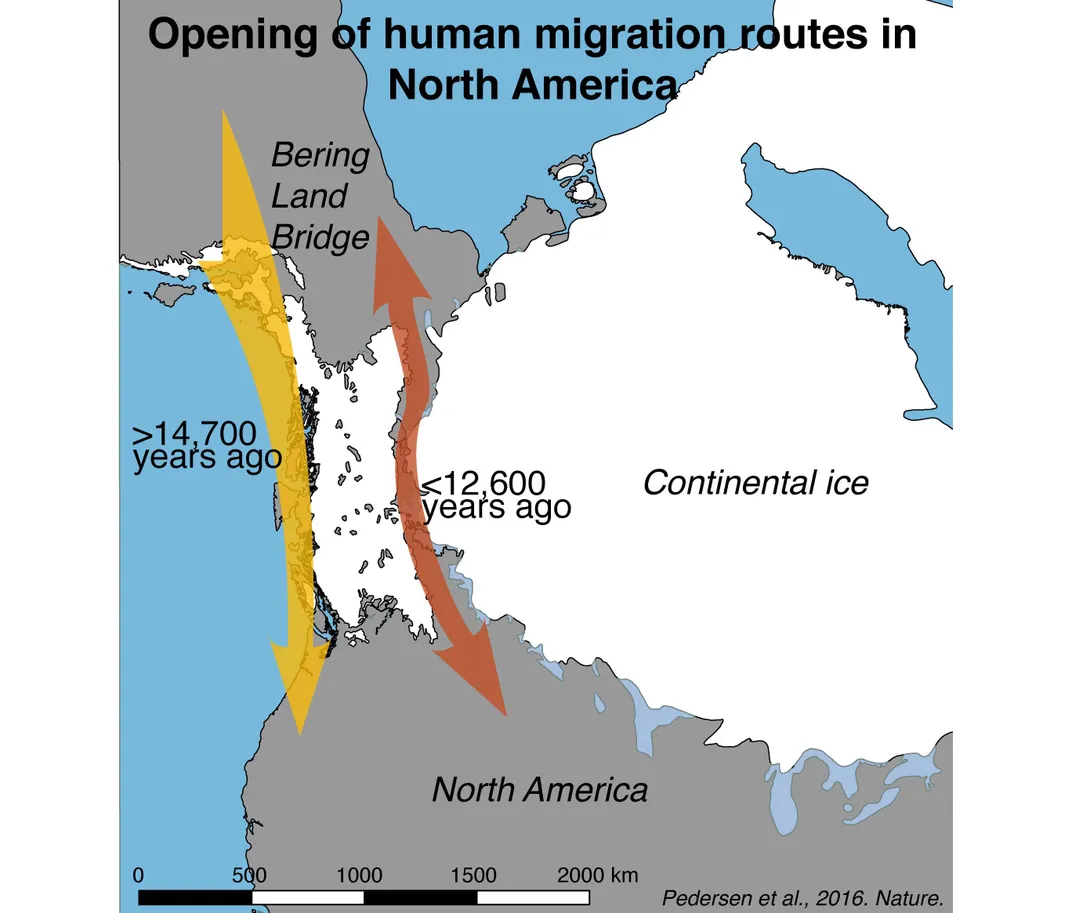First Humans Entered the Americas Along the Coast, Not Through the Ice
Evidence mounts against the traditional story of early human migration through an ice corridor
/https://tf-cmsv2-smithsonianmag-media.s3.amazonaws.com/filer/18/d5/18d58d5b-2a24-43e9-b7a9-fd7947a0d079/ice_free_route.jpg)
The traditional story of human migration in the Americas goes like this: A group of stone-age people moved from the area of modern-day Siberia to Alaska when receding ocean waters created a land bridge between the two continents across the Bering Strait. Once across, the giant Laurentide and Cordilleran ice sheets, which blocked southern Alaska and the Yukon Territory in western Canada, halted the migrants' progress. But about 13,000 years ago, the ice sheets began retreating, opening a 900-mile-long ice-free corridor following the Canadian Rockies. This, many researchers believe, is how the Clovis culture moved south and colonized other parts of the Americas.
But new evidence has made that timeline hazy over the last decade. Research shows that humans were living south of the ice sheets before the ice-free corridor opened up. A settlement in Monte Verde, Chile, shows people had made it all the way down South America 15,000 years ago and a more recent discovery indicates that humans hunted mammoth in Florida 14,500 years ago.
Now, a new study by an international team of researchers may finally rip the ice corridor hypothesis out of the textbooks once and for all. Using sediment cores and DNA analysis, the scientists reconstructed the corridor's environment. This research shows that there just weren’t enough resources in the pass for the earliest human migrants to successfully make the crossing.
“The bottom line is that even though the physical corridor was open by 13,000 years ago, it was several hundred years before it was possible to use it,” project leader Eske Willerslev, an evolutionary geneticist from the University of Copenhagen and Cambridge University, says in a press release. “That means that the first people entering what is now the US, Central and South America must have taken a different route. Whether you believe these people were Clovis, or someone else, they simply could not have come through the corridor, as long claimed.”

Nicholas Wade at The New York Times reports the researchers looked at an area of the ice-free corridor that was once part of a large lake dubbed Glacial Lake Peace that would have blocked the path. The migrants would not have been able to cross the 6,000-square-mile body of water until it began to recede, an event that would show up in the lake bed sediments in the remains of plants and animals.
Today, that area is covered by Lake Charlie in British Columbia and Spring Lake in Alberta. The team visited the lakes during winter, drilling down into the lake beds to gather sediment cores.
They then applied a technique called “shotgun sequencing” to the materials they brought up, which allowed them to date when plants and animals began colonizing the lake bed. “Instead of looking for specific pieces of DNA from individual species, we basically sequenced everything in there, from bacteria to animals,” Willerslev says in the release. “It’s amazing what you can get out of this. We found evidence of fish, eagles, mammals and plants.”
Wade reports that the scraps of ancient DNA show how Lake Peace receded, slowly opening the ice corridor. Grasses, sedges, birch and willow began colonizing the edges of the shrinking lake, and as it dried, they found evidence of bison, voles, and jack rabbits moving in starting around 12,500 years ago. That means it’s unlikely the area produced enough resources like food and wood for the long migration before that date. Instead, early humans probably followed the Pacific Coast around the ice sheets when colonizing the Americas.
The study echoes another paper that came out in June. In that study, researchers looked at the DNA of northern and southern populations of bison concluding they did not intermingle until 13,000 years ago, meaning the corridor was blocked till then.
Now, to complete the story of human migration in the Americas researchers need to focus on evidence along the coast. That's tricky since erosion, tides and now the effects of climate change make coastal archeological sites very rare.